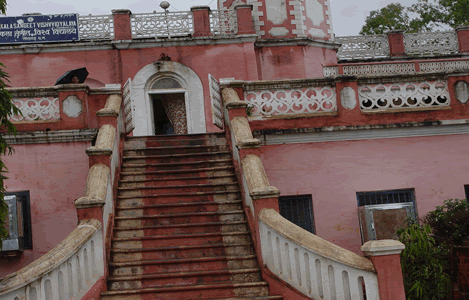|
Asia's
only university dedicated
to visual and performing arts

Photograph
by Preeti Verma Lal
The clinking
of the ghungroos, the melodious ragas and sound of the hammer chipping off marble
and granite mingle with the pitter-patter of the rain. It is dusk and the century-old
pink building is lit randomly. It looks beautiful with the setting sun as the
backdrop; Indira Kala Sangeet Vishwavidyalaya lives its reputation at every breath.
Even if you set it aside as an architect's joy, the University remains unique
- it is the only university in Asia dedicated to performing and visual arts.
The
clinking of the ghungroos, the melodious ragas and sound of the hammer chipping
off marble and granite mingle with the pitter-patter of the rain. It is dusk and
the century-old pink building is lit randomly. It looks beautiful with the setting
sun as the backdrop; Indira Kala Sangeet Vishwavidyalaya lives its reputation
at every breath. Even if you set it aside as an architect's joy, the University
remains unique - it is the only university in Asia dedicated to performing and
visual arts. And it owes its existence to Princess
Indira of Khairagarh. Daughter of Raja Birendra Bahadur Singh and Rani Padmavati
Devi, little Indira had an ear for music and Sa Re Ga Ma her only route to bliss.
The Raja started a music school for the princess but when Death intervened and
Indira died young, a disconsolate Raja donated his palace to open a university
dedicated solely to music and fine arts.
Today, the 48-year old university
continues to be the final word in visual and performing arts. "The
university offers courses in music, dance, folk music and arts, visual arts and
history of Indian art and culture," informs Dr Purinma Pande, vice-chancellor,
an accomplished kathak dancer and former vice-chancellor of Bhatkande University
of Music in Lucknow. The department of vocal music offers
unique programs in Hindustani and Carnatic styles, including Hindustani khayal
and drupad-dhamar. Students can enroll in the eight-year diploma course that is
divided into prathma, madhayma, vid and kovid. In the
instrumental category, students can pick up the nuances of playing the sitar,
sarod, flute, violin, tabla, pakhawaj and mridangam. "We
also teach the students the principles of musicology, psychology, philosophy and
aesthetics of music, but what is remarkable is that nowhere do they teach the
physics of sound. That is something unique from our repertory," adds Dr Pande.
The department of dance offers under-grad, post-graduate as well as M.Phil,
D.Litt and Ph.D programs in different dance forms, but it is bharatnatyam that
occupies the pride of place amongst all dance forms. Rich
in folk music and art tradition, IKSV has contributed a lot in preserving the
folk traditions of Madhya Pradesh and Chattisgarh. If colors
fascinate you and if the easel or the hammer is your favorite friend, IKSV has
a lot to offer, like the Bachelor of Fine Arts and Master of Fine Arts in painting,
sculpture and graphics. The university has 45 affiliated
colleges, one affiliated research center and several examination centers throughout
the country. Besides, the intensive courses that it offers,
IKSV also boasts of a rich museum that houses some rare archaeological remains
and art. In its Classical and Folk Music Instruments Gallery, one can glimpse
really rare instruments, like the panchmookhi tabla, the magar yad, singor yad,
saz-e-Kashmir, ghatams, and the Nakul veena, which is said to derive its name
from Nakul who was an adept veena player. Khairagrah,
which takes its name from the innumerable khair (katha) trees that lived in the
area, is today synonymous with all that is melodic and inspired. Published
in Discover India magazine, September 2004. | 
